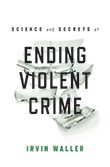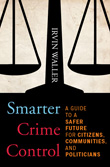Mass shootings dominate the headlines, but it is street violence that leads to far and away the most homicides and serious injuries in the US – many thousands young men dieing each year. CDC adds to the prevalence of unnecessary tragedies by confirming the shocking numbers of young women who will be raped – likely over a million each year.
This violence is not inevitable, it is preventable. If state and local governments used the conclusions from today´s violence prevention science as many as 8000 lives would be saved and half a million women would not be raped. If saving lives is not enough, preventing violence would save billions of dollars spent on policing and mass incarceration, while investing in the futures of young people in disadvantaged zip-codes.
Irvin Waller is an internationally recognized expert on violence prevention and victim rights. He has published a new book, “Science and the Secrets of Ending Violent Crime,” to shift policies to saving lives, protecting women and investing in people. In the book, he has brought together the violence prevention science, the cities that have successfully reduced violence and the benefits from stopping violence to communities and pocket books. He has then gone a giant step further forward to spike the myths that prevention is unaffordable and unpopular with voters. He has provided the actions to get buy-in from politicians. “Science and the Secrets of Ending Violent Crime,” is written to shift policy to save lives by writing for both politicians and the public.
The proof that violence prevention works is freely available on websites such as crimesolutions.gov of the US Department of Justice and others internationally. These portals access thousands of clinical trials that show which projects have stopped crime before it happens. There are academic reviews of the science. But not surprisingly to Waller, these portals and academic reviews are not enough to get better investments in prevention.
So he translated the science into concrete actions, where innovations have achieved a reduction in crime 50% better than the current systems of policing, courts and incarceration. These innovations are simple and practical projects that tackle the causes of violence by outreaching to youth in difficulty, supporting better parenting, teaching life skills in schools, and problem oriented policing.
Further analyses of these projects available on a portal of the State of Washington shows these projects are remarkably cost effective by stopping harm to victims and saving the costs of reacting after crime has happened. These prove an ounce of prevention is worth a pound of cure.
But freely available is not the same as widely known or easily used. In the few cases, where the successes have been adapted in cities in the US and other countries using a plan, political leaders have achieved city wide reductions of 50% or better and with sustained funding have kept violent crime rates low. Boston achieved a 60% reduction in gun violence in the 1990´s but did not sustain the success. Minneapolis and Glasgow in Scotland have achieved similar reductions and maintained funding to continue the success.
Waller spent time on the Board of the US National Organization for Victim Assistance and is an ardent advocate for victims rights. He justifies action on prevention because it prevents the tragedies that make up the annual statistics of violent crime. These numbers reflect men and women who have lost their lives, families who have been devastated by loss and pain, individuals whose quality of life has been destroyed, and victimized children who suffer and then go through consequential chronic disease and emotional anguish. Violent crimes affect the economies where the crimes occur.
“Are we shocked by the statistics, by the ruin violent crime causes in homes and communities throughout the world? asked Waller. “We should be. We also should be shocked that the policies and practices of criminal justice systems lag behind so many other domains. For example, medical advances are enabling us to live longer with a greater quality of life. Technological innovations never stop, offering us more and more gadgets with which to play and work. We are even conquering outer space and finding cures for cancer.
“Why isn’t the current system of criminal justice making a dent in the slaughter and senseless destruction of human life taking place? he asked. “The bottom line is that, in the thriving domains, decision makers have applied science in a way that criminal justice policy makers have not. To make matters worse, this means that everyday people continue to pay ever increasing taxes for a reactive criminal justice system that is neither the most effective nor cost-effective solution for dealing with violent crime.”
So how do we make the transformations to make our communities safer. In the book, Irvin Waller goes much further as he uses his unique experience in the US and across the world in being asked to help politicians put the science to work. Effective violence prevention is not only more affordable and successful than policymakers think; a modest equivalent of 10 percent of what they spend on police, courts, and corrections will do it and often before the next election! Violence prevention is achievable because voters, contrary to what the media tells us, want much more than reaction, they want prevention. Yes they want tough on crime, but they also want tough on causes.
In his groundbreaking book, Waller focuses on internationally agreed but little known conditions that are essential for governments to successfully implement that science. He highlights cities that have started to prevent violence. He shows how to reduce and ultimately stop violence by considering how governments spend our money, manage our cities, and legislate our community safety. He draws on the successes and disappointments from the USA and other advanced democracies to show the way to the transformations that will achieve the significant reductions in violent crime that are measurable before 2030 for the Sustainable Development Goals.
“Science and the Secrets of Ending Violent Crime,” will provide the new movements to stop gun violence and violence against women with science based and so proven ways to achieve their goals. Waller brings the truth to the reader, increasing not only their knowledge of the problem at hand, but introducing practical ways to get more involved in making our world free from violence.
Irvin Waller is an author and emeritus professor, who is a prize-winning champion of victim’s rights and violence prevention. Governments, Non-governmental organizations and intergovernmental agencies across the world – in the USA, UK, Latin America and elsewhere – seek him as a speaker and adviser. His trail blazing work in 1985 to get the UN General Assembly to recognize rights for victims earned him multiple awards, including from the US National Organization for Victim Assistance. This led to more than 30 years working on the problems facing the world´s most crime ridden cities – particularly in advanced democracies – and so his unique ability to use science and success in one country to make advances in another.
“Science and the Secrets of Ending Violent Crime,” is available from amazon.com and at better bookstores nationwide.

